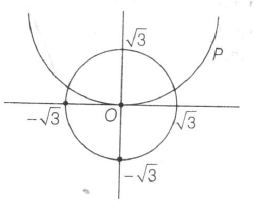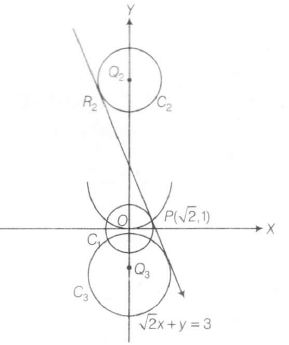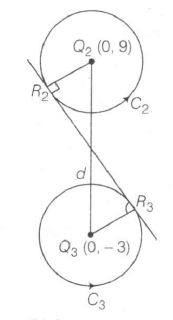Answer:
Option A,B,C
Explanation:
Given,
$C_{1}:x^{2}+y^{2}=3$ intersects the parabola $x^{2}=2y$

On solving $x^{2}+y^{2}=3$ and $x^{2}=2y$
get
$y^{2}+2y=3$
$\Rightarrow$ $y^{2}+2y-3=0$
$\Rightarrow$ $(y+3)(y-1)=0$
$\therefore$ y=1,-3
[ neglecting y=-3,as $-\sqrt{3}\leq y\leq\sqrt{3}$ ]
$\therefore$ y=1
$\Rightarrow$ $x=\pm\sqrt{2}$
$\Rightarrow$ $P(\sqrt{2},1)\epsilon $I quadrant.
Equation of tangent at $P(\sqrt{2},1)$ to $C_{1}:x^{2}+y^{2}=3$ is
$\sqrt{2}x+1.y=3$ ............(i)
Now, let the centres of $C_{2}$ and $C_{3}$ be $Q_{2}$ and $Q_{3}$, and tangent P touches $C_{2}$ and $C_{3}$ , at
$R_{2}$ and $R_{3}$ shown in below

Let $Q_{2}$ be (o,k) and radius is $2\sqrt{3}$
$\therefore$ $\frac{|0+k-3|}{\sqrt{2+1}}=2\sqrt{3}$
$\Rightarrow$ $|k-3|=6\Rightarrow k=9,-3$
$Q_{2}$ (0,9) and $Q_{3}$ (0,-3)
Hence, $Q_{2}$$Q_{3}$=12
$\therefore$ Option (a) is correct.
Also, $R_{2}$ $R_{3}$ is common internal tangent to $C_{2}$ and $C_{3}$
and $r_{2}=r_{3}=2\sqrt{3}$
$R_{2}R_{3}=\sqrt{d^{2}-(r_{1}+r_{2})^{2}}$
= $R_{2}R_{3}=\sqrt{12^{2}-({4\sqrt{3}})^{2}}$
$=\sqrt{144-48}=\sqrt{96}=4\sqrt{6}$

$\therefore$ Option (b) is correct
$\therefore$ Length of perpendicular from O(0,0) to $R_{2}$ $R_{3}$ is equal to radius $C_{1}=\sqrt{3}$
$\therefore$ area of $\triangle OR_{2}R_{3}$ = $\frac{1}{2}\times R_{2}R_{3}\times\sqrt{3}$
= $\frac{1}{2}\times 4\sqrt{6}\times\sqrt{3}$
= $6\sqrt{2}$
$\therefore$ Option (c) is correct
Also , area of $\triangle PQ_{2}Q_{3}$ = $\frac{1}{2}Q_{2}.Q_{3}\times\sqrt{2}$
= $\frac{1}{2}\times12\times\sqrt{2}=6\sqrt{2}$
$\therefore$ Option (d) is incorrect.